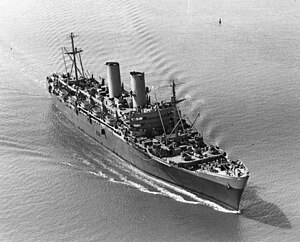
USS Admiral W. L. Capps (AP-121), an Admiral W. S. Benson-class transport, was the second ship of the United States Navy to be named for Rear Admiral Washington L. Capps (1864–1935). Unusually, the first — USS Capps (DD-550) — served concurrently with the Admiral W. L. Capps. Via a transfer to the United States Army and then back to the Navy, the ship was renamed USNS General Hugh J. Gaffey (T-AP-121), making her the only ship to be named for Hugh Joseph Gaffey.
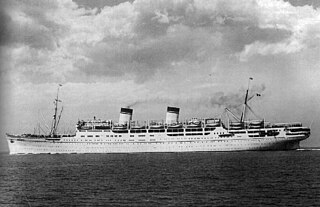
SS Conte Grande was a Lloyd Sabaudo ocean liner built in 1927 by Stabilimento Tecnico Triestino in Trieste, Italy, to service the transatlantic passenger line between Genoa, Italy, and New York City. Launched on 29 June 1927, her maiden voyage was from Genoa to Naples to New York City, which occurred on 13 April 1928. In 1932, after acquisition by the Italian Line, she was transferred to the South America service but was laid up in Santos, Brazil in 1940.

USS General G. O. Squier (AP-130) was the lead ship of her class of transport ship for the U.S. Navy in World War II. Decommissioned in 1946, she was sold privately in 1965 and renamed SS Pennmar, and was eventually scrapped.

The General G. O. Squier class of transport ships was built for the U.S. Navy during World War II. The class was based upon the Maritime Commission's Type C4 ship. The class was named for United States Army Major General George Owen Squier.

USS General O. H. Ernst (AP-133) was a General G. O. Squier-class transport ship for the U.S. Navy in World War II. She was named in honor of U.S. Army general Oswald Herbert Ernst. She was decommissioned in 1946 and transferred to the Army Transport Service as USAT General O. H. Ernst. She was sold privately in 1964 and renamed SS Calmar, and was scrapped in 1980.
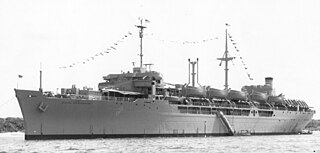
USS General R. M. Blatchford (AP-153) was a General G. O. Squier-class transport ship for the U.S. Navy in World War II. She was named in honor of U.S. Army general Richard M. Blatchford. She was transferred to the U.S. Army as USAT General R. M. Blatchford in 1946. On 1 March 1950 she was transferred to the Military Sea Transportation Service (MSTS) as USNS General R. M. Blatchford (T-AP-153). She was later sold for commercial operation under the names SS Stonewall Jackson and Alex Stephens, before being scrapped in 1980.

USS General R. L. Howze (AP-134) was a General G. O. Squier-class transport ship for the U.S. Navy in World War II. The ship was crewed by the U.S. Coast Guard throughout the war. She was named in honor of U.S. Army general Robert Lee Howze. She was transferred to the U.S. Army as USAT General R. L. Howze in 1946. On 1 March 1950 she was transferred to the Military Sea Transportation Service (MSTS) as USNS General R. L. Howze (T-AP-134). She was later sold for commercial operation under the name SS Austral Glen, before being scrapped in 1980.

USS General W. M. Black (AP-135) was a General G. O. Squier-class transport ship for the U.S. Navy in World War II. The ship was crewed by the U.S. Coast Guard until decommissioning. She was named in honor of U.S. Army general William Murray Black. She was transferred to the U.S. Army as USAT General W. M. Black in 1946. On 1 March 1950 she was transferred to the Military Sea Transportation Service (MSTS) as USNS General W. M. Black (T-AP-135). She was later sold for commercial operation under the name SS Green Forest, before being scrapped in 1980.

USS General W. F. Hase (AP-146) was a General G. O. Squier-class transport ship for the US Navy in World War II. She was named in honor of US Army Major General William Frederick Hase. She was transferred to the US Army as USAT General W. F. Hase in 1946. On 1 March 1950 she was transferred to the Military Sea Transportation Service (MSTS) as USNS General W. F. Hase (T-AP-146). She was later sold for commercial operation in 1968, before being scrapped in 1985.
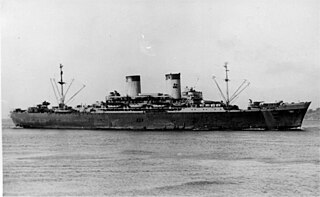
USS General A. E. Anderson (AP-111) was a troop transport that served with the United States Navy in World War II and the Korean War.

USS General W. A. Mann (AP-112) was a troop transport that served with the United States Navy in World War II, the Korean War and the Vietnam War.

USS General W. P. Richardson (AP-118) was a troopship that served with the United States Navy in World War II. She was later transferred to the United States Army and served briefly during the Korean War as USAT General W. P. Richardson before entering commercial service.

USS General W. H. Gordon (AP-117) was a troop transport that served with the United States Navy in World War II. After the war, she was transferred to the US Army and served as USAT General W. H. Gordon. In the mid to late 1940s she sailed in trans-Pacific American President Lines passenger service with sister ship SS General Meigs. With the outbreak of the Korean War, she was reacquired by the Navy as a civilian-crewed Military Sea Transportation Service (MSTS) vessel, and redesignated USNS General W. H. Gordon (T-AP-117). She served again under the same designation in the Vietnam War.
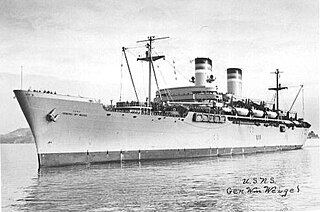
USS General William Weigel (AP-119) was a troopship that served with the United States Navy in World War II. After the war, she was acquired by the US Army and became USAT General William Weigel. On the outbreak of the Korean War, she was transferred to the Military Sea Transportation Service (MSTS) and designated USNS General William Weigel (T-AP-119), a designation she retained for her later service in the Vietnam War.
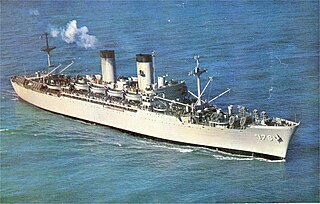
USS General J. C. Breckinridge (AP-176) was a troopship that served with the United States Navy in World War II, the Korean War and the Vietnam War. In October 1949 she was redesignated T-AP-176 but retained her Navy crew. Her namesake was United States Marine Corps Lieutenant General James Carson Breckinridge (1877-1942), who was the grandson of John Cabell Breckinridge, who served as Vice President of the United States from 1857 to 1861.

USNS Sgt. Sylvester Antolak (AP-192/T-AP-192) was a Boulder Victory-class cargo ship that served as a United States Army Transport, and in the United States Navy's Military Sea Transportation Service, in the post-World War II period.

The Type C4-class ship were the largest cargo ships built by the United States Maritime Commission (MARCOM) during World War II. The design was originally developed for the American-Hawaiian Lines in 1941, but in late 1941 the plans were taken over by the MARCOM.
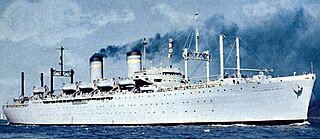
USS Admiral R. E. Coontz (AP-122) was an Admiral W. S. Benson-class transport built for the U.S. Navy during World War II. She was laid down under a Maritime Commission contract on 15 January 1943 at Alameda, California, by the Bethlehem Steel Corp., and launched on 22 April 1944. She was sponsored by Mrs. Edwin Kokko, daughter of Admiral Coontz, and commissioned on 21 November 1944.

USNS Private Joe P. Martinez (T-AP-187) was a Boulder Victory-class cargo ship built for the United States Navy during the closing period of World War II. The ship was named after Private Joe P. Martinez, a Medal of Honor recipient.
USNS Marine Carp (T-AP-199) was a Marine Adder-class transport that saw service with the US Navy for the task of transporting troops to and from combat areas. She was of the C4-S-A3 design type.
